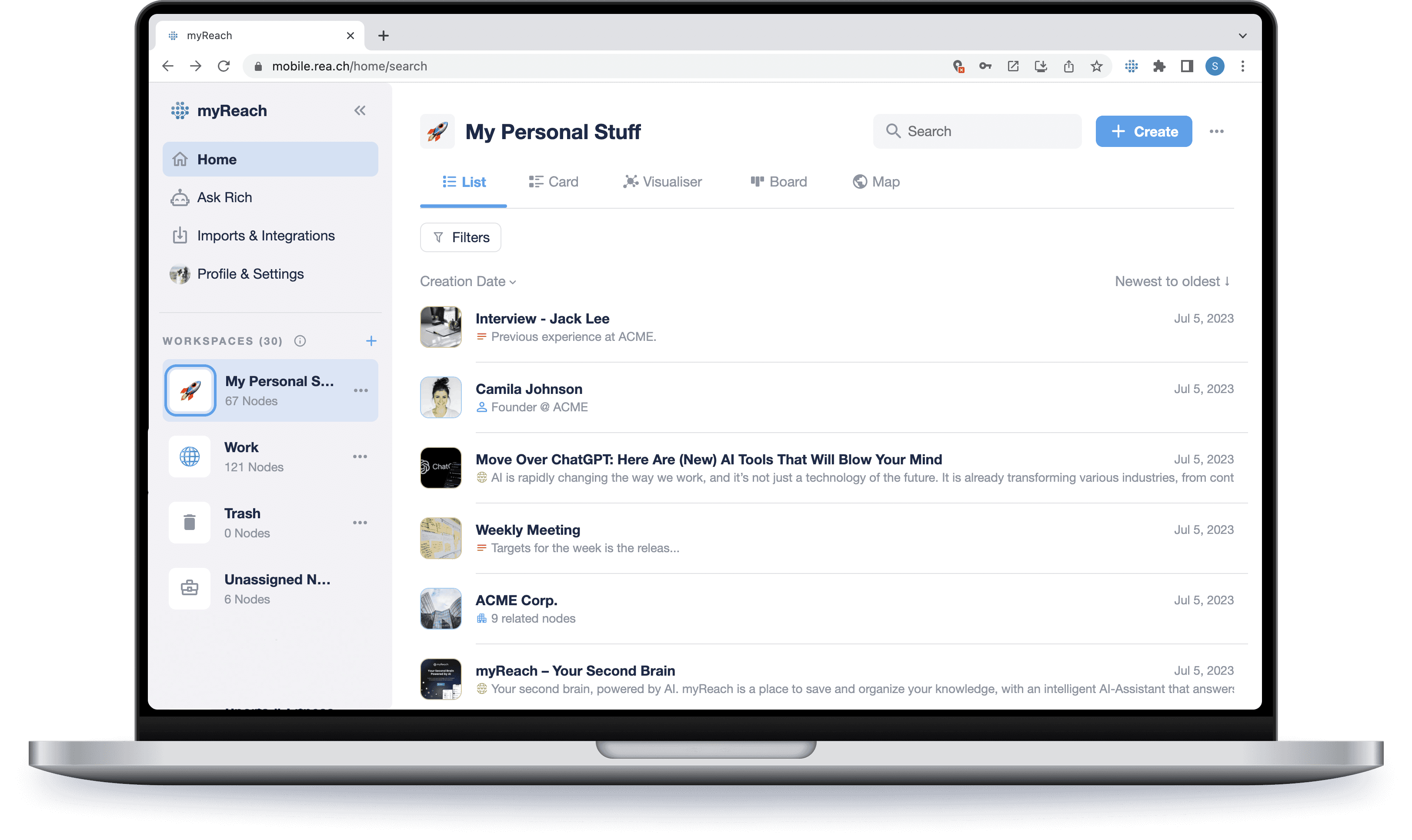






In today’s information-driven world, managing and organising knowledge effectively is a critical skill. The concept of a “second brain” has gained popularity as a way to augment our cognitive abilities and enhance productivity. A second brain is essentially an external system that complements our natural memory by capturing, storing, and retrieving information on our behalf. With the advent of artificial intelligence (AI), building a second brain has become more achievable and efficient.
How AI can build a Second Brain
AI plays a crucial role in building a second brain by automating and optimising various processes. Here are some ways AI can assist:
INTELLIGENT INFORMATION CAPTURE
AI-powered tools can intelligently capture and organise information from various sources. Whether it’s articles, documents, web pages, or personal notes, AI algorithms can extract essential details and store them in a structured manner within your second brain.
NATURAL LANGUAGE PROCESSING (NLP)
NLP enables AI to understand and process human language effectively. By leveraging NLP, AI-powered second brain apps can interpret your queries and retrieve relevant information, making it easier to find what you need when you need it.
CONTEXTUAL KNOWLEDGE RETRIEVAL
AI can recognise context and relationships between different pieces of information. This contextual understanding enables your second brain to provide more relevant and comprehensive insights, leading to better decision-making.
SMART ORGANISATION AND TAGGING
With AI’s ability to analyze content, it can intelligently organize and tag information within your second brain. This ensures that related data is grouped together logically, making it easier to navigate and access.
The Second Brain Technique
The second brain technique is a methodology for managing and processing information inspired by Tiago Forte’s PARA (Projects, Areas, Resources and Archives) framework. It involves categorising knowledge into four main pillars:
PROJECTS:
Organising information related to ongoing projects, including tasks, goals, deadlines and resources.
AREAS:
Grouping knowledge based on different areas of focus, such as personal development, career, hobbies or health.
RESOURCES:
Storing reference materials, articles and valuable resources that support your projects and areas of interest.
ARCHIVES:
Archiving completed projects and less frequently accessed information, keeping your active workspace clutter-free.
By structuring your second brain using this technique, you create a well-organized and accessible knowledge repository.
myReach: Your Ultimate Second Brain App
When it comes to building a second brain, myReach stands out as a powerful AI-driven app that streamlines knowledge management. myReach acts as a personal ChatGPT, capturing, storing and retrieving information the way you think.
Key Features of myReach:
Intuitive Knowledge Capture: With AI-powered intelligent information capture, myReach makes it effortless to add and organise content to your second brain.
Contextual Understanding: Leveraging NLP and context recognition, myReach provides relevant insights and connections within your stored knowledge.
Seamless Organisation: Using the second brain technique, myReach helps you categorise information into Workspaces, with Tags and relationships for a clutter-free organisation.
Advanced Search: The AI-powered chat, Rich, enables you to retrieve information from your saved things quickly and efficiently.
Building a second brain with myReach empowers you to stay organised, access information with ease and enhance your productivity.

What can you Add to Your Second Brain?
Your second brain is a dynamic repository that can house various types of information, including but not limited to:
Personal Notes: Ideas, thoughts and reflections.
Task Lists: To-do lists, project milestones and deadlines.
Research Materials: Articles, research papers and reference materials.
Web Clippings: Relevant web pages and bookmarks.
Meeting Notes: Notes from meetings, workshops or conferences.
Images and Visuals: Infographics, diagrams and visual aids.
Contacts and Networking: Business cards and contact details.
By adding diverse information to your second brain, you create a comprehensive knowledge base that empowers you to navigate the complexities of work and life more efficiently.
In today’s information-driven world, managing and organising knowledge effectively is a critical skill. The concept of a “second brain” has gained popularity as a way to augment our cognitive abilities and enhance productivity. A second brain is essentially an external system that complements our natural memory by capturing, storing, and retrieving information on our behalf. With the advent of artificial intelligence (AI), building a second brain has become more achievable and efficient.
How AI can build a Second Brain
AI plays a crucial role in building a second brain by automating and optimising various processes. Here are some ways AI can assist:
INTELLIGENT INFORMATION CAPTURE
AI-powered tools can intelligently capture and organise information from various sources. Whether it’s articles, documents, web pages, or personal notes, AI algorithms can extract essential details and store them in a structured manner within your second brain.
NATURAL LANGUAGE PROCESSING (NLP)
NLP enables AI to understand and process human language effectively. By leveraging NLP, AI-powered second brain apps can interpret your queries and retrieve relevant information, making it easier to find what you need when you need it.
CONTEXTUAL KNOWLEDGE RETRIEVAL
AI can recognise context and relationships between different pieces of information. This contextual understanding enables your second brain to provide more relevant and comprehensive insights, leading to better decision-making.
SMART ORGANISATION AND TAGGING
With AI’s ability to analyze content, it can intelligently organize and tag information within your second brain. This ensures that related data is grouped together logically, making it easier to navigate and access.
The Second Brain Technique
The second brain technique is a methodology for managing and processing information inspired by Tiago Forte’s PARA (Projects, Areas, Resources and Archives) framework. It involves categorising knowledge into four main pillars:
PROJECTS:
Organising information related to ongoing projects, including tasks, goals, deadlines and resources.
AREAS:
Grouping knowledge based on different areas of focus, such as personal development, career, hobbies or health.
RESOURCES:
Storing reference materials, articles and valuable resources that support your projects and areas of interest.
ARCHIVES:
Archiving completed projects and less frequently accessed information, keeping your active workspace clutter-free.
By structuring your second brain using this technique, you create a well-organized and accessible knowledge repository.
myReach: Your Ultimate Second Brain App
When it comes to building a second brain, myReach stands out as a powerful AI-driven app that streamlines knowledge management. myReach acts as a personal ChatGPT, capturing, storing and retrieving information the way you think.
Key Features of myReach:
Intuitive Knowledge Capture: With AI-powered intelligent information capture, myReach makes it effortless to add and organise content to your second brain.
Contextual Understanding: Leveraging NLP and context recognition, myReach provides relevant insights and connections within your stored knowledge.
Seamless Organisation: Using the second brain technique, myReach helps you categorise information into Workspaces, with Tags and relationships for a clutter-free organisation.
Advanced Search: The AI-powered chat, Rich, enables you to retrieve information from your saved things quickly and efficiently.
Building a second brain with myReach empowers you to stay organised, access information with ease and enhance your productivity.

What can you Add to Your Second Brain?
Your second brain is a dynamic repository that can house various types of information, including but not limited to:
Personal Notes: Ideas, thoughts and reflections.
Task Lists: To-do lists, project milestones and deadlines.
Research Materials: Articles, research papers and reference materials.
Web Clippings: Relevant web pages and bookmarks.
Meeting Notes: Notes from meetings, workshops or conferences.
Images and Visuals: Infographics, diagrams and visual aids.
Contacts and Networking: Business cards and contact details.
By adding diverse information to your second brain, you create a comprehensive knowledge base that empowers you to navigate the complexities of work and life more efficiently.
In today’s information-driven world, managing and organising knowledge effectively is a critical skill. The concept of a “second brain” has gained popularity as a way to augment our cognitive abilities and enhance productivity. A second brain is essentially an external system that complements our natural memory by capturing, storing, and retrieving information on our behalf. With the advent of artificial intelligence (AI), building a second brain has become more achievable and efficient.
How AI can build a Second Brain
AI plays a crucial role in building a second brain by automating and optimising various processes. Here are some ways AI can assist:
INTELLIGENT INFORMATION CAPTURE
AI-powered tools can intelligently capture and organise information from various sources. Whether it’s articles, documents, web pages, or personal notes, AI algorithms can extract essential details and store them in a structured manner within your second brain.
NATURAL LANGUAGE PROCESSING (NLP)
NLP enables AI to understand and process human language effectively. By leveraging NLP, AI-powered second brain apps can interpret your queries and retrieve relevant information, making it easier to find what you need when you need it.
CONTEXTUAL KNOWLEDGE RETRIEVAL
AI can recognise context and relationships between different pieces of information. This contextual understanding enables your second brain to provide more relevant and comprehensive insights, leading to better decision-making.
SMART ORGANISATION AND TAGGING
With AI’s ability to analyze content, it can intelligently organize and tag information within your second brain. This ensures that related data is grouped together logically, making it easier to navigate and access.
The Second Brain Technique
The second brain technique is a methodology for managing and processing information inspired by Tiago Forte’s PARA (Projects, Areas, Resources and Archives) framework. It involves categorising knowledge into four main pillars:
PROJECTS:
Organising information related to ongoing projects, including tasks, goals, deadlines and resources.
AREAS:
Grouping knowledge based on different areas of focus, such as personal development, career, hobbies or health.
RESOURCES:
Storing reference materials, articles and valuable resources that support your projects and areas of interest.
ARCHIVES:
Archiving completed projects and less frequently accessed information, keeping your active workspace clutter-free.
By structuring your second brain using this technique, you create a well-organized and accessible knowledge repository.
myReach: Your Ultimate Second Brain App
When it comes to building a second brain, myReach stands out as a powerful AI-driven app that streamlines knowledge management. myReach acts as a personal ChatGPT, capturing, storing and retrieving information the way you think.
Key Features of myReach:
Intuitive Knowledge Capture: With AI-powered intelligent information capture, myReach makes it effortless to add and organise content to your second brain.
Contextual Understanding: Leveraging NLP and context recognition, myReach provides relevant insights and connections within your stored knowledge.
Seamless Organisation: Using the second brain technique, myReach helps you categorise information into Workspaces, with Tags and relationships for a clutter-free organisation.
Advanced Search: The AI-powered chat, Rich, enables you to retrieve information from your saved things quickly and efficiently.
Building a second brain with myReach empowers you to stay organised, access information with ease and enhance your productivity.

What can you Add to Your Second Brain?
Your second brain is a dynamic repository that can house various types of information, including but not limited to:
Personal Notes: Ideas, thoughts and reflections.
Task Lists: To-do lists, project milestones and deadlines.
Research Materials: Articles, research papers and reference materials.
Web Clippings: Relevant web pages and bookmarks.
Meeting Notes: Notes from meetings, workshops or conferences.
Images and Visuals: Infographics, diagrams and visual aids.
Contacts and Networking: Business cards and contact details.
By adding diverse information to your second brain, you create a comprehensive knowledge base that empowers you to navigate the complexities of work and life more efficiently.
In today’s information-driven world, managing and organising knowledge effectively is a critical skill. The concept of a “second brain” has gained popularity as a way to augment our cognitive abilities and enhance productivity. A second brain is essentially an external system that complements our natural memory by capturing, storing, and retrieving information on our behalf. With the advent of artificial intelligence (AI), building a second brain has become more achievable and efficient.
How AI can build a Second Brain
AI plays a crucial role in building a second brain by automating and optimising various processes. Here are some ways AI can assist:
INTELLIGENT INFORMATION CAPTURE
AI-powered tools can intelligently capture and organise information from various sources. Whether it’s articles, documents, web pages, or personal notes, AI algorithms can extract essential details and store them in a structured manner within your second brain.
NATURAL LANGUAGE PROCESSING (NLP)
NLP enables AI to understand and process human language effectively. By leveraging NLP, AI-powered second brain apps can interpret your queries and retrieve relevant information, making it easier to find what you need when you need it.
CONTEXTUAL KNOWLEDGE RETRIEVAL
AI can recognise context and relationships between different pieces of information. This contextual understanding enables your second brain to provide more relevant and comprehensive insights, leading to better decision-making.
SMART ORGANISATION AND TAGGING
With AI’s ability to analyze content, it can intelligently organize and tag information within your second brain. This ensures that related data is grouped together logically, making it easier to navigate and access.
The Second Brain Technique
The second brain technique is a methodology for managing and processing information inspired by Tiago Forte’s PARA (Projects, Areas, Resources and Archives) framework. It involves categorising knowledge into four main pillars:
PROJECTS:
Organising information related to ongoing projects, including tasks, goals, deadlines and resources.
AREAS:
Grouping knowledge based on different areas of focus, such as personal development, career, hobbies or health.
RESOURCES:
Storing reference materials, articles and valuable resources that support your projects and areas of interest.
ARCHIVES:
Archiving completed projects and less frequently accessed information, keeping your active workspace clutter-free.
By structuring your second brain using this technique, you create a well-organized and accessible knowledge repository.
myReach: Your Ultimate Second Brain App
When it comes to building a second brain, myReach stands out as a powerful AI-driven app that streamlines knowledge management. myReach acts as a personal ChatGPT, capturing, storing and retrieving information the way you think.
Key Features of myReach:
Intuitive Knowledge Capture: With AI-powered intelligent information capture, myReach makes it effortless to add and organise content to your second brain.
Contextual Understanding: Leveraging NLP and context recognition, myReach provides relevant insights and connections within your stored knowledge.
Seamless Organisation: Using the second brain technique, myReach helps you categorise information into Workspaces, with Tags and relationships for a clutter-free organisation.
Advanced Search: The AI-powered chat, Rich, enables you to retrieve information from your saved things quickly and efficiently.
Building a second brain with myReach empowers you to stay organised, access information with ease and enhance your productivity.

What can you Add to Your Second Brain?
Your second brain is a dynamic repository that can house various types of information, including but not limited to:
Personal Notes: Ideas, thoughts and reflections.
Task Lists: To-do lists, project milestones and deadlines.
Research Materials: Articles, research papers and reference materials.
Web Clippings: Relevant web pages and bookmarks.
Meeting Notes: Notes from meetings, workshops or conferences.
Images and Visuals: Infographics, diagrams and visual aids.
Contacts and Networking: Business cards and contact details.
By adding diverse information to your second brain, you create a comprehensive knowledge base that empowers you to navigate the complexities of work and life more efficiently.


